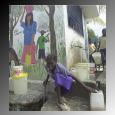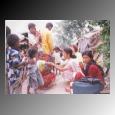|


POVERTY AND HOMELESSNESS
Homeless issues vary on a state-to-state basis. However, some general themes occur within the developed and developing countries. With respect to developed countries most of the homeless are single mothers who are unable to find affordable housing, youth escaping abuse, or those who want to distance themselves from the system.
On the other hand, many developing countries those has had internal conflict in the past have many who simply had to escape those conflicts in order to survive or were displaced by the conflict itself. As many developed countries find themselves struggling in the global economy where they have tariffs raised on their competitively advantageous products (textiles and primary products) many people had to move in order to find better economic opportunities.
There is, however, one single aspect that is common to homeless people everywhere: Poverty, the lack of finances, and little hope. The problem of homelessness is far from solved, as affordable housing is always a hotly debated issue by governments in the developed world. In the developing world, many countries are still politically unstable, where government use the suffering of their people as pawns in the international arena. Again, innovative approaches must be undertaken to alleviate the problem of homelessness.

EDUCATING HOMELESS CHILDREN & YOUTH
Self-Assessment Guide
Identification of Barriers to the Education of Homeless Children
INTRODUCTION
The self-assessment guide was developed with the philosophy that schools can make a difference. Schools can provide a stabilizing environment, a haven from the chaos of homelessness. Schools can provide the quality of educational experience to empower homeless students to break the cycles of poverty, dependency, and homelessness. Schools can provide a critical link between the community and homeless children and their families. If Kansans truly believe that "all children can learn", then they will recognize that homeless children and youth are indeed educable and very capable of a positive contribution to our society.
The guide, modeled on an exemplar produced by the Texas Education Agencys Division of Special Programs planning and implementation, attempts to help schools answer the questions, "What can we do to help homeless children? How can we help homeless children learn?" This guide is not a compliance document. Rather, it is designed to assist schools to self-identify those policies and practices that inhibit the educational attainment of homeless children and youth.
The guide is divided into the following four sections: Enrollment and Identification; Awareness and Environment; Educational Access; and Support Services .
Each section consists of questions that serve as indicators of the extent to which a school is addressing the needs of homeless students. Affirmative answers to the questions listed in the guide should highlight areas in which the school demonstrates the concern, commitment, and creativity necessary to help ensure that homeless children and youth enroll in school, attend classes, and achieve success. In situations where a school cannot answer affirmatively, the question may suggest an area in which the school can establish goals and seek to improve the quality of its services.
INSTRUCTIONS FOR COMPLETING THE SELF-ASSESSMENT GUIDE
1. The self-assessment guide was designed to help individual schools assess their effectiveness in meeting the needs of homeless students. Each school should assess itself. A small number of the questions address districtwide actions. Schools that cannot respond affirmatively to these questions may choose to encourage appropriate action at the district level.
2. The self-assessment process is most effective when conducted by individuals representing a variety of perspectives. Therefore, the school should select a committee to include teachers, professional and nonprofessional support staff, administrators, representatives of local shelters and service agencies, parents of homeless students, and, in some cases, homeless students.
3. After completing each section of the guide, the committee should recommend goals and objectives related to its findings. The committee may choose to make recommendations related to those issues which are most important to the enrollment, attendance, and success of homeless students.
4. The committee should develop a written report, including goals and objectives relating to responses to the self-assessment guide questions. The report should be considered in the development of all school plans, including school improvement plans and budgeting requests. The report should be made available to school personnel, shelter personnel, community members, and school board officials.
5. In adopting the report of the assessment committee, the school is urged to simultaneously adopt systems for monitoring progress toward accomplishing the goals

|

